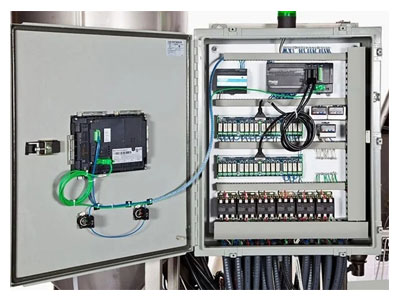Where Is PLC Used?
Key Takeaway
PLCs (Programmable Logic Controllers) are indispensable tools that underpin automation across various industries, playing a critical role in enhancing efficiency, productivity, and safety. Among the sectors that heavily rely on PLCs are automotive manufacturing, where these controllers are integral to controlling assembly line robots, managing inventory systems, and ensuring precision in manufacturing processes. In the food and beverage industry, PLCs regulate the operation of production lines, monitor temperature and pressure levels in processing equipment, and facilitate batch control to maintain quality standards. Across these diverse industries, PLCs streamline operations, enable remote monitoring and control, and support data-driven decision-making, ultimately driving efficiency and competitiveness in today’s dynamic industrial landscape.
Industries That Rely on PLCs
PLCs serve as the backbone of automation in industries such as automotive manufacturing, food and beverage processing, pharmaceuticals, and oil and gas. These sectors rely on PLCs to control machinery, monitor processes, and ensure efficient production with minimal human intervention.

Common Applications of PLCs in Manufacturing
In the dynamic realm of manufacturing, PLCs serve as indispensable tools, orchestrating a symphony of machinery and processes to ensure smooth operations and optimal productivity. These programmable marvels take charge of assembly lines, conveyor systems, and robotic arms, synchronizing their movements with precision.
Moreover, PLCs take on the role of a vigilant overseer, managing inventory levels efficiently to prevent stockouts or overages, thus maintaining uninterrupted production flow. Quality control measures are also seamlessly integrated into the manufacturing process by PLCs, ensuring that each product meets stringent standards before it reaches the market.
Their ability to adapt to changing demands and streamline complex tasks makes PLCs the backbone of modern manufacturing facilities. Whether it’s orchestrating intricate workflows or fine-tuning production parameters, PLCs empower engineers and operators to drive efficiency, consistency, and excellence in manufacturing operations.
Use of PLCs in Process Control
In the intricate landscape of process industries, PLCs emerge as indispensable assets, offering a robust framework for controlling and monitoring critical variables essential for operations. Industries like chemical processing, water treatment, and power generation rely heavily on PLCs to maintain stringent control over parameters such as temperature, pressure, and flow rates.
At the heart of these operations, PLCs act as vigilant guardians, continuously collecting data from sensors and instruments dispersed throughout the facility. Through real-time monitoring and feedback mechanisms, PLCs enable operators to make informed decisions swiftly, ensuring processes remain within safe operating limits and meet regulatory requirements.
Moreover, PLCs facilitate the implementation of sophisticated control algorithms, allowing for precise adjustments to be made in response to fluctuations in process conditions. This level of control not only enhances operational efficiency but also minimizes the risk of accidents and ensures the quality and consistency of end products.
In essence, PLCs serve as the cornerstone of process control systems, providing engineers and operators with the tools they need to navigate the complexities of modern industrial processes with confidence and precision.
PLCs in Building Automation and Smart Systems
In the realm of building automation, PLCs stand as indispensable tools, orchestrating a symphony of interconnected systems to streamline operations and enhance the overall functionality of buildings. By interfacing with an array of sensors, actuators, and devices, PLCs empower building managers to regulate heating, ventilation, lighting, and security systems from a centralized platform.
This centralized control not only simplifies management but also contributes to substantial energy savings by optimizing resource usage based on real-time data and occupancy patterns. Moreover, PLCs enable buildings to adapt dynamically to changing environmental conditions, ensuring occupants’ comfort while minimizing energy waste.
In addition to enhancing comfort and energy efficiency, PLCs play a crucial role in bolstering security measures within buildings. By integrating with access control systems, surveillance cameras, and alarm systems, PLCs enable proactive monitoring and response to potential security threats, safeguarding both occupants and assets.
In essence, PLCs serve as the backbone of modern building automation and smart systems, offering engineers and building managers the tools they need to create safer, more comfortable, and energy-efficient environments.
Future Trends in PLC Applications
Looking into the future, PLCs are on the brink of a transformative journey, embracing cutting-edge technologies to revolutionize industrial automation. One such trend is the integration of PLCs with the Internet of Things (IoT), paving the way for enhanced connectivity and data exchange between devices and systems. By harnessing the power of IoT, PLCs will enable remote monitoring, predictive maintenance, and data-driven decision-making, ushering in a new era of efficiency and reliability.
Furthermore, the incorporation of artificial intelligence (AI) into PLC systems holds immense promise for optimizing processes and enhancing performance. AI algorithms will empower PLCs to analyze vast amounts of data in real-time, identifying patterns, predicting failures, and autonomously adjusting parameters to optimize operations.
Moreover, the emergence of edge computing technology will enable PLCs to process data closer to the source, reducing latency and improving responsiveness. This decentralized approach to data processing will not only enhance system performance but also enable PLCs to operate effectively in distributed environments.
In essence, the future of PLCs is brimming with potential, with advancements in IoT, AI, and edge computing poised to redefine the landscape of industrial automation, driving efficiency, and innovation to new heights.
Conclusion
From automotive plants to water treatment facilities, PLCs continue to revolutionize industrial automation, offering unparalleled flexibility, reliability, and scalability. As industries evolve and technology advances, PLCs will remain at the forefront of innovation, driving efficiency, productivity, and sustainability across diverse sectors.
